Diamond rush
A few lucky souls have stumbled on diamonds in glacial debris around the Great Lakes and further north into Canada for centuries. Geologists have known that the sources of those diamonds represented a vast wealth of hidden treasure somewhere in the frozen tundra of northern Canada, but it was not until the late 1980s that a couple of cowboy geologists, Chuck Fipke and Stewart Blusson, painstakingly ferreted their way back to the source. But I am getting way ahead of the story.
Diamonds are brought to the surface from deep within the upper mantle via unusual igneous rocks called kimberlites (and sometimes lamproites). I recognize I run the risk of losing my readers by delving into the nature of kimberlites, but to a geologist like myself kimberlites are crazy types of rocks. Typical magmas (and lavas) like basalt form by partial melting of the mantle. Kimberlites, on the other hand, are geologically unique because although they form from partial melting of the mantle, the melting is significant enough for these rocks to resemble compositionally (not precisely) the mantle itself. They are referred to as ultramafic rocks as compared with basalts which are mafic (mafic means rich in magnesium and iron – two of the most abundant elements in the mantle).
Diamonds actually don’t form in kimberlites. Think of kimberlites as a conveyor belt bringing diamonds that form under high temperatures and pressures (from about 125 to 175 kilometers1) to the surface relatively fast, before they can reequilibrate (breakdown) into other compounds like graphite or carbon dioxide. Diamonds are not forever. Many an exploration program has had its hopes dashed with the discovery of kimberlite full of octahedral or other cubic forms of graphite — degraded diamonds2.
Exploration for diamonds can be excruciatingly frustrating. There are 6,400 known kimberlite pipes worldwide but only 30 or so have become viable mines — that’s about 0.5% chance that a discovered kimberlite will turn into a producing mine. It’s true, diamondniferous kimberlites are hard to find, but you don’t need many diamonds to make a mine. High-grade diamond kimberlites only contain a few carats per ton of rock. That’s enough to make any geologist rich beyond her dreams. Kimberlites form at greater than 200 kilometer depths (200 to 600 km) and are enriched in volatiles (e.g., carbon dioxide and water) that make the magmas not only buoyant but explosive. They literally “blow” through the upper mantle and crust in perhaps a matter of hours (rates postulated are about 14 km/hr) forming carrot-shaped pipes called diatremes (see the diagram below). The faster the better for diamond preservation. But they also have to pick diamonds up along the way or incorporate them as the magma forms. Kimberlites can contain as much as 25 to 50 percent rock within their magma acting as an elevator to the surface for mantle material helping geologists understand the mantle3.
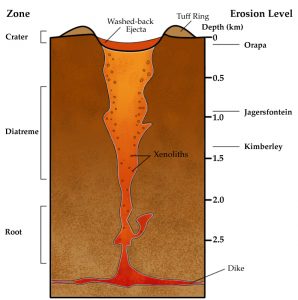 Asbestos Wikipedia
Asbestos Wikipedia
After half a century or more of serious diamond exploration. we have learned that diamond-bearing kimberlites form below the cratons. The cratons are the ancient regions of continents containing rocks greater than 2 billion years old. There is still great debate about how the cratons formed, but every continent is rooted in these ancient environs. If you are looking for diamonds, go to the cratons. Before the 1980s, diamond kimberlite mines had been developed on every craton of all the continents except Antarctica and North America. Diamonds come from two major sources: mantle rock (e.g., peridotite) and eclogite (metamorphosed basalt). Diamond formation in peridotites occurred primarily in the Archean centered on a time about 3 to 3.3 billion years ago but some dates are as young as 1.9 billion years ago. Eclogite diamonds tend to be younger from 1 to 2.9 billion years ago.
Where does the carbon come from to form diamonds? No one knows for sure, but most researchers think that the carbon along with sediments and volatiles were subducted through plate tectonics (the ecologites brought up by kimberlites are likely ancient subducted ocean floor)4. I am interested, through my own research, on how the cratons formed and when subduction began. Many geologists pooh-pooh the idea that subduction could have begun so early in earth history so it is satisfying to see how diamond research supports the early existence of plate tectonics and subduction. My colleagues and I have contended for years that the cratons are the result of ancient subduction.
Imagine Chuck Fipke in the 1980s looking out over the vast expanses of northern Canada contemplating all the diamonds he believed had to be out there in the craton hidden below tons of glacial deposits. Those damnable glacial deposits were the reason no one had discovered pipes in Canada5. The map below shows the furthest extent of the glaciers 17,000 years ago and the site of the diamond pipes eventually discovered. Fipke also had to contend with De Beers, the giant cartel that controlled the world’s diamond markets. They were actively exploring with their practically unlimited resources. I worked for De Beers as a consulting geologist for a time in the mid 1990s in Russia, and I can assure you, they are a force to be reckoned with.
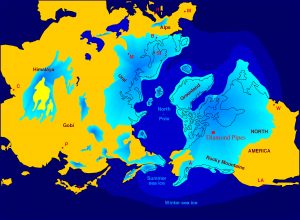 Base map from Wikipeida
Base map from Wikipeida
By the mid 1980s, geologists had discovered that the mantle material brought up by kimberlites could aid them in their exploration thanks to a geochemist named John J. Gurney at the University of Capetown. Diamonds form in equilibrium at specific temperatures and pressures with other minerals more abundant than diamonds. Gurney, funded by Superior Oil, analyzed extensive mineral assemblages from kimberlites with and without diamonds and found that there are chemical signatures in the minerals that show up when diamonds are present. One of the more famous diagrams is that of the chromium and calcium concentrations in garnets from the mineral assemblages. Garnets fall into two groups on the diagram called G10 and G9 and virtually all garnets that occur with diamonds fall within the G10 field shown below. As mentioned before, diamonds can reequilibrate in kimberlites and become graphite or evaporate away as carbon dioxide. The diagram shows the line of stability under chromium saturation where diamonds will breakdown. Some diamonds remain stable in the graphite field because the conditions do not last long enough to degrade the diamonds. But if G10 garnets fall above the diamond-graphite equilibrium line it is a pretty sure bet you are on the right track for diamondiferous kimberlites. And that is precisely what Fipke kept finding in in his samples of glacial debris as he flew along with Blusson (who not only has a PhD but is a pilot) periodically sampling them. The long-gone glaciers were pointing the way.
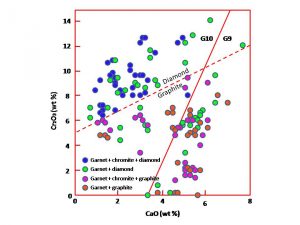 After Nowicki et al., 2007
After Nowicki et al., 2007
At the time in the mid 1980s, geologist understood the relationships between these indicator minerals and diamonds, but how could the information be used to find the kimberlites in the Canadian craton? What was unique about Fipke and his partner Blusson was the way they approached the problem. They knew that the glaciers were powerful enough to gouge out the relatively soft kimberlite and carry the indicator minerals long distances destroying any signs of the kimberlites at the surface and subsequently burying them under debris carried by the glaciers when they melted. They reasoned that they might be able to sample glacial deposits and “walk” the indicator minerals back to their source. Standard Oil liked the idea and funded their exploration at first. No one knew then that it would take eight years, millions of exploration dollars, and several companies before they hit pay dirt. De Beer’s geologists also knew the answer was in the glacial remains, but to them it was a nine to five job and the season ended after 8 weeks of summer collecting. For Fipke, it was a life’s dream, and nothing terminated his resolve collecting well into the cold months of the far north.
Fipke and Blusson focused on eskers (see the esker shown below) which are sinuous ridges of stratified sand and gravel deposited by water flowing in tunnels of ice within or under the glaciers. As the glaciers recede the ridges remain like compasses indicative of the direction the water and ice once flowed. If the glaciers rumbled over kimberlites, the proof would be in the streams that carried the glacial till away. They kept going even after Standard Oil called it quits. The G10 garnets kept telling them they were on the right road and the mining giant BHP believed them when they began running out of money. Dia Met, the company Fipke and Blusson formed, signed a sweet deal with BHP. BHP agreed to fund the exploration for a 51% stake. Within six months after teaming with BHP, Fipke had come to a point where the G10 garnets disappeared near Lac de Gras. Fipke knew he was close to the source. As the story goes, he noticed a lake from the air that looked like it sat in a bowl-shaped depression near where the G10 garnets disappeared. He had to have a sample of the rock in that depression. They landed the plane on the lake, rowed to shore, and started to dig, but after many hours they were still in glacial till. They decided to walk the shoreline for a better place to dig. That is when Fipke’s son Mark, found a piece of kimberlite. They were all ecstatic — the lake must sit on the pipe. Gurney eventually analyzed the mineral assemblage and verified that it was highly likely to be a diamond-bearing kimberlite. BHP quickly flew a geophysical survey which showed a distinct structure below the lake.
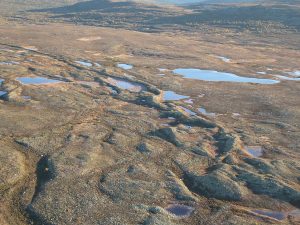 Esker in Sweden (Hanna Lokrantz Wikipedia)
Esker in Sweden (Hanna Lokrantz Wikipedia)
BHP and Dia Met started quietly staking as much land around the lake as they could. Kimberlite pipes frequently occur in bundles so it was imperative that they obtain rights to as large a region as possible before word got out of the find. While they were staking, BHP flew a drill rig in by helicopter and cored 455 feet under the lake pulling out beautiful samples of kimberlite 33 feet below the glacial debris with 80 plus small diamonds. Canadian law requires that companies announce to their shareholders when a potentially profitable body is found. On November 12, 1991 they announced the results from the core including the fact that a few gem-quality diamonds had been recovered from the core. All hell broke loose, and the rush was on by large and small companies alike to stake as close to BHP’s claims as possible in the hopes that other pipes might be buried nearby. BHP would go on to discover more than 150 kimberlite pipes helping to make Canada the third largest producer of diamonds in the world. De Beers even found a few mines. Fipke and Blusson became billionaires overnight (if you don’t count the 8 years of exploration).
The image below shows the Etaki mine – one of the producing mines staked within Fipke’s original claims. The large circular depressions in kmberlite represent part of the open-pit mining operations BHP is running.
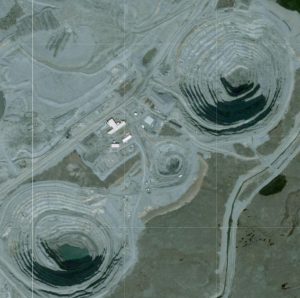 Ekati mines from the air (Google Maps)
Ekati mines from the air (Google Maps)
- Shirey, S. B. and Richardson, S. H. (2011) Start of the Wilson Cycle at 3 Ga shown by diamonds from subcontinental mantle: Science 333, 434-436 ↩
- Pearson, D. G., Davies, G. R., Nixon, P. H., and Milledge, H. (1989) Graphitized diamonds from a peridotite massif in Morocco and implications for anomalous diamond occurrences: Nature, 338, 60-62 ↩
- Russell, J. K., Porritt, L. A., and Hilchie, L. (2013) Kimberlite: rapid ascent of lithospherically modified carbonatitic melts: In Pearson, D. G. et al, Proceedings of 10th International Kimberlite Conference Vol. 1 p. 195-210 ↩
- Nowicki, T. E., et al. (2007) Diamonds and associated heavy minerals in kimberlite: A review of key concepts and applications: Developments in Sedimentology, 58, 1235-1267 ↩
- Cross, L. D. (2011) Treasure Under the Tundra: Canada’s Arctic Diamonds: Heritage House Publishing Co ↩

My knowledge previously was in hindsight very misinformed. I thought that diamonds were a forever material that primarily came from mining locations. I had the image in my head that diamonds were found by panning for gold, mining in caves, and were for the most part a fairly simple process. Though in actuality, the procedure for gathering diamonds is very boring and laborious, as well as discouraging, because diamonds in fact do not last forever. Diamonds are created down into the mantle and brought up by the conveyor belt effects of the kimberlite. With that finding, it became easy to pinpoint possible diamond rich mines. But in glaciers, the task was a little more problematic because the indicator materials used to recognize possible diamond mines, would get washed away in the melted ice and extinguish any and all signs of the kimberlites at the surface. Fipke and Blusson figured out a way to work through that problem. Their method, focused on the eskers. In this way, they were able to plot out the flow of water and basically be able to locate the cause of the marker minerals by pursuing the trails left behind in the eskers.
One question I had at the end of the reading, was if diamonds are degraded in the Earth’s surface, why are we taught are whole lives that diamonds are the hardest materials.
-Kathryn Carlin
Before reading this article, I had a preconceived notion that I thought was correct on how diamonds were made. After reading it I figured out that I was completely wrong. In fact, I never knew that former and current glacial movement had anything to do with diamonds. Which leaves me a little confused when I think about the diamond mines in Africa, I never thought about it but were their glaciers on Africa at some time in history. I will definitely look into this just to educate myself on this, but back to the article. It was interesting to learn about the kimberlites and how they act as a conveyor to bring the diamonds up the pipes. Another amazing fact was about the age of diamonds. Which it does make a lot of sense for them to take this long to make due to the pressure needed to create them, but how they only happen to be found along these ancient lines is truly astonishing. Considering when you see the areas that other gems are found. It is a bit disappointing that there is no such line in North America. Then only to read that this team was on the verge of being able to find them in Canada, even though most were telling him that it was a wild “goose chase”. I know it was mentioned at a time that you worked for DeBeers, but you kind of have to be excited that it wasn’t them that gained control over the majority of the mines and that another competitor was able to come in and stake a claim to the market.
One thing I took away from this article actually has little to do with the science in the article. What I get out of it more than anything is determination. To have this much belief in yourself and your knowledge to follow through is amazing. With all of the factors against them, they continued to push forward with the mission. I do not see it mentioned, but I would bet that at some points in this endeavor the finances had to be close to gone. Then they get hope with the help of a partner only to have that partner give up after several years. Just imagine the disappointment that they would have felt, and even with that they kept pushing forward. I truly believe this article could be one of those that could be used to convince people around the world to never give up on anything, keep pushing forward. If you believe in yourself and have strong convictions that you know that you will find what you are looking for then go for it.
Kimberlites are unique ultramafic igneous rocks that closely resemble the mantle compositionally, more so than other igneous rocks because the melting is significant enough. These rocks will occasionally transport diamond xenocrysts to the surface by incorporating them into the forming magma. Kimberlites form at greater than 200 kilometer depths and explosively erupt at about 14 km/hr through carrot-shaped pipes known as diatremes. Out of the known 6,400 kimberlite pipes, only 30 have become viable mines for diamonds. These diamond bearing rocks can be found in cratons, or ancient parts of the continents containing rocks greater than 2 billion years old. There are two major sources for diamonds: peridotite and eclogite. The peridotite sourced diamonds formed about 3 to 3.3 billion years ago and the younger eclogite sourced diamonds formed 1 to 2.9 billion years ago. Most researchers tend to believe that the carbon necessary for the diamonds (along with sediments and volatiles) were subducted.
John J. Gurney, a geochemist at University of Capetown discovered that there are chemical signatures in the minerals that correlate with the diamonds. For example, garnets fall into groups called G10 or G9, and the garnets of the G10 group are associated with diamonds. In order for geologists Fipke and Blusson to find diamonds hidden by glacial deposits, they had to work on it for several years. They did this by following the G10 garnets. Eventually, they came to a place where the garnets had disappeared near Lac De Gras and knew they were close to the source. After they analyzed the mineral assemblage of the piece of kimberlite they found at the lake, they verified it was likely it was diamond-bearing. Furthermore, the mining company funding the geologists, BHP, did a geophysical survey that showed a distinct structure below the lake. They quietly obtained rights to the land around the lake and began uncovering samples of kimberlite containing some gem quality diamonds. BHP went on to discover more than 150 kimberlite pipes and Fipke and Blusson achieved their eight-year long goal.
I know the focus of this article was on kimberlites, but I’d also be interested in seeing subsequent articles about other diamond-bearing rocks like orangeites and lamproites and why they aren’t as popular of a source.
Diamonds are created between 125 and 175 kilometers under the surface of the earth. They are the result of high pressure and temperatures on carbon and other minerals. Diamonds are brought to the surface by kimberlites, which is magma that closely resembles the composition of the mantle and has a high iron and magnesium content. What makes kimberlites special is that they contain a lot of volatile substances such as carbon dioxide and water. These volatile substances cause the magma to move faster than normal and “blow” up to the surface, picking up diamonds on the way. The speed is the important factor here. If the diamonds are in the magma for too long, the will start to break down into other compounds and destroy their value. Kimberlites form under cratons, which are areas of the mantle that are older than 2 billion years.
Two geologists, Chuck Fipke and Stewart Blussen, using the work of geochemist John J. Gurney, set off to hunt for diamonds in Canada. Gurney discovered that there is a certain chemical composition of kimberlites that usually contain diamonds. Their technique was to analyze samples of the till left behind by receding glaciers in hopes of finding some sign of diamond yielding kimberlite. Once they found some, they followed the path of the glacier until there was no longer any sign if the diamond yielding kimberlite, at which point they knew they had gone past it. They found the source beneath a lake in a crater. Since that time, there has been enough diamonds discovered in Canada to make in the third largest producer in the world.
Summary:
Diamonds are in fact not a forever kind of thing, and this article has completely changed the way most people would have though diamonds were formed and found! Diamonds are actually formed very deep below the earth’s surface under high temperature and pressure. They are actually brought to the surface through kimberlites, which are basically like a pipeline delivering them to the surface; a “conveyor belt” you called it. Through long years of research scientists have been able to come to the conclusion that diamonds are formed in two ways; mantle rock and eclogite and actually could probably prove that plate tectonics and subduction existed billions of years ago and were part of this process. Fipke and Blusson actually went on an 8 year journey trying to find kimberlite pipelines by following glacier paths and sampling rock deposits. This ended up paying off in the end of their hard work because they soon became billionaires after they found ove 150 kimberlite pipelines and started a company called Dia Met.
This was really interesting to me because I actually really had no idea how diamonds were created, and the last place I would’ve guessed was deep below the earth’s surface! Also, I had no idea that diamonds do not exist forever because they can actually break down into other minerals (if I read and understood that correctly). This really surprised me because I, again, had no idea how diamonds were created or mined. I honestly thought they were just in caves above ground and created through billions of years.
After reading your article, I was able to learn exactly how diamonds come to the surface via kimberlite rocks; yet that is not where they originate from. However, kimberlites are a vital step in how diamonds rise to the surface and it was intriguing to know exactly what they are; rocks formed from melting mantle. Searching for diamonds is no easy task, and you have a very minimal (0.5%) chance of even locating any in kimberlite pipes. While searching for said diamonds, you better hope that the kimberlites blew through the upper mantle and crust; or the diamonds will not be well preserved at all. There are two types of major sources that diamonds come from, mantle rock and eclogite (I had never even heard of eclogite until reading this article, but sound intriguing); and both are over a billion years old! Gurney found that there are chemical signatures in the minerals that show up when diamonds are present, thus showing that certain chemicals need to be present in the kimberlites in order for diamonds to sustain themselves. Diamonds have the capacity to re-equilibrate in kimberlites, as well as become graphite or evaporate away as carbon dioxide.
Over all I really enjoyed reading your article regarding the gold rush as it has always been an interesting topic to learn about, not matter what age. Especially considering no one ever really teaches nor speaks about how the diamonds exist in the glacier debris around the northern part of the United States, as well as lower Canada.
-Annemarie Ferencz
I really enjoyed this article. After reading the first paragraph, I remembered watching a documentary a few years back about Chuck Fipke and Stewart Blusson, and their search for diamonds in Canada. I used to watch Discovery channel all the time, to see stuff like this. I knew that diamonds were created deep in the earth and needed heat and pressure, but did not know how they came to the surface, or close enough to be mined. I also did not know that they could be destroyed by magma, I thought that “diamonds are forever.”
One thought I had while reading this article was that if diamonds are possibly created at old subduction zones, why are there not diamonds in or around any of the volcanoes that are currently active in subduction zones. After some thought, I realized that currently active volcanoes would be too young for the diamonds to have formed. Maybe in a couple billion years there will be diamonds in what is now known as the “ring of fire.” Another reason there is probably not diamonds around currently active volcanoes is because, as far as I know, there is usually a slow buildup of magma underneath before they blow, and that would destroy them, breaking them back down into carbon and other minerals. Obviously, volcanoes like those in Hawaii, which seem to be a constant trickle of lava, would destroy diamonds long before they made it to the surface.
Many preconceived notions of not only diamond mining, but also portions of the Earth, I had were proved wrong after reading this article. I would not have thought that magma in kimberlites flowing up against gravity could be flowing and bringing up diamonds at a proposed 14 km/hr. It is strange how there is only a 0.5% chance in finding diamonds in kimberlites, even though that is where diamonds come up from in the Earth. I was also not aware that diamond could be degraded in the Earth’s crust. Maybe it is all the advertisements I’ve heard from diamond jewelry stores, or the fact that diamonds are very hard material, but I was under the impression that a diamond could last for many thousands of years at least. It’s also very fascinating how researching diamonds help scientists study the early earth, and early plate tectonics. Fipke researching and mining for diamonds in the conditions he and his team did it in is quite remarkable, especially competing with the infamous DeBeers diamond company.
-Max DiRamio
Interesting article regarding how diamonds are made and the adventure of discovering the diamond mine in Canada. I did not know that diamonds were boosted to the surface by rocks called kimberlites. Additionally, there is a specific high grade kimberlite that is linked to diamonds that are formed below the cratons. If I read your article correctly not only are diamonds not forever because they decompose to graphite if not brought to the surface timely in the carrot shaped pipes, it appears that they may also be finite due to the right circumstances being needed for them to form. I do wonder which diamonds are more valuable the diamonds formed in peridotite or eclogite? Does one generate better diamonds than the other?
Great discovery around indicator minerals by John Gurney. This allowed Fipke to follow the clues provided by his samples that lead him to the lake. I commend the perseverance of both Fipke and Blusson. They were well rewarded for not giving up even when faced with competition like De Beers and their unlimited resources which is apparently only viable in the summer. Fipke and Blusson believed in what the science was telling them and was able to convince BHP which resulted in a significant return on 8 years invested. Thank you for sharing this article.
Based on your article, the process for finding diamonds is rather tedious and somewhat frustrating due to the fact that diamonds don’t last forever. Diamonds are created down into the mantle and brought up by the conveyor belt effects of the kimberlite. With that discovery it became easy to locate possible diamond rich mines. But in glaciers, the task was a bit more difficult because the indicator materials used to identify possible diamond mines, would get washed away in the melted ice and destroy nay sign of the kimberlites at the surface. Fipke and Blusson figured out a way to work through that problem. By focusing on the eskers, they were able to map out the flow of water and essentially be able to locate the source of the source of the indicator minerals by following the trails left behind in the eskers.
I always had this idea that one would just walked into a cave and start scraping off the wall to dig out huge blocks of diamonds. It never occurred to me that so much work went into first locating them and then finally screening the dirt to find just a few carats of diamonds per ton of rocks.
I went ahead and looked into how the diamonds are mined once it is determined that an area could potentially contain diamonds. The two most common ways are: alluvial and pipe mining. Alluvial mining is done in revers or beaches where the diamonds had been washed up from the rocks to the surface. The sand is then screened to take out the diamonds. The other methods is when the diamonds are extracted from natural pipes through man-made caves.
In your article it was mentioned that a lot of times, that only a few kimberlite pipes are actually viable mines. What effects does mining these rock have on the geosphere?
The effect on the geosphere with diamonds is not as harsh as other mining techniques usually. I am not an expert on mining engineering but most of the time I believe the rock simply needs to be be crushed up and the diamonds sorted. Alluvial mining is even easier because the deposits are usually soft sediment. You can “pan” this like you would gold. I was doing a consulting job in Sierra Leone years ago where people were working the alluvial deposits by the thousands.
Without a reasonable doubt this article was extremely interesting, no disrespect to your other articles this one was without a doubt the most interesting one in my perspective. It could be that this one article solves all of our mining fantasies from childhood of one day finding a diamond buried in our backyard. I do have a couple of questions and hope that they do not seem stupid.
1. being that as you described kimberlites are referred to as ultramafic rocks as compared with basalts which are mafic (mafic means rich in magnesium and iron – two of the most abundant elements in the mantle). wouldn’t it be easier to use a type of magnetic detection sonar or metal detector of sort to find these kimberlites as the magnesium’s paramagnetisim is stronger in lower temperature and the kimberlites contain high iron
2. Think of kimberlites as a conveyor belt bringing diamonds that form under high temperatures and pressures (from about 125 to 175 kilometers1) to the surface relatively fast, before they can reequilibrate (breakdown) into other compounds like graphite or carbon dioxide. Diamonds are not forever. Many an exploration program has had its hopes dashed with the discovery of kimberlite full of octahedral or other cubic forms of graphite — degraded diamonds
– does this ultimately mean that the more continuous and rapid that we mine for diamonds the more diamonds we find? being as the are stopped from degrading
3. wouldn’t there be a form of making the kimberlite in the degraded pipes rise quicker? maybe some type of fracking but not as pooh-pooh of a method that doesn’t harm our planet.
This is quite an interesting article to say the least. Diamonds like every commodity in the world are valued by the trek that was required to acquire them. Before reading this article i was unaware of how tedious the process of finding diamonds was. Reading that diamonds are brought to the surface from deep within the upper mantle via unusual igneous rocks called kimberlites (and sometimes lamproites) , makes it seem as if they are spewed in the surface for the picking but with further reading you learn that they are most certainly not. There are 6,400 kimberlite pipes worldwide but only 30 have good mines. so basically finding a kimberlite pipe is the equivalent of finding the best spot to pan pyrite, unless you find diamonds then its the equivalent of striking gold. which is rare since there is about 0.5% chance that a discovered kimberlite will turn into a producing mine.
The article then goes into the amazing adventures of Fipke and Blouson, the diamond duo that figured out a way to work through the problem being unable to pinpoint diamond barring locations utilizing eskers. trusting there science Fipke and Blouson demonstrated such a level of dedication that they convinced BHP, resulting in a significant return on 8 years invested making them billionaires over night.